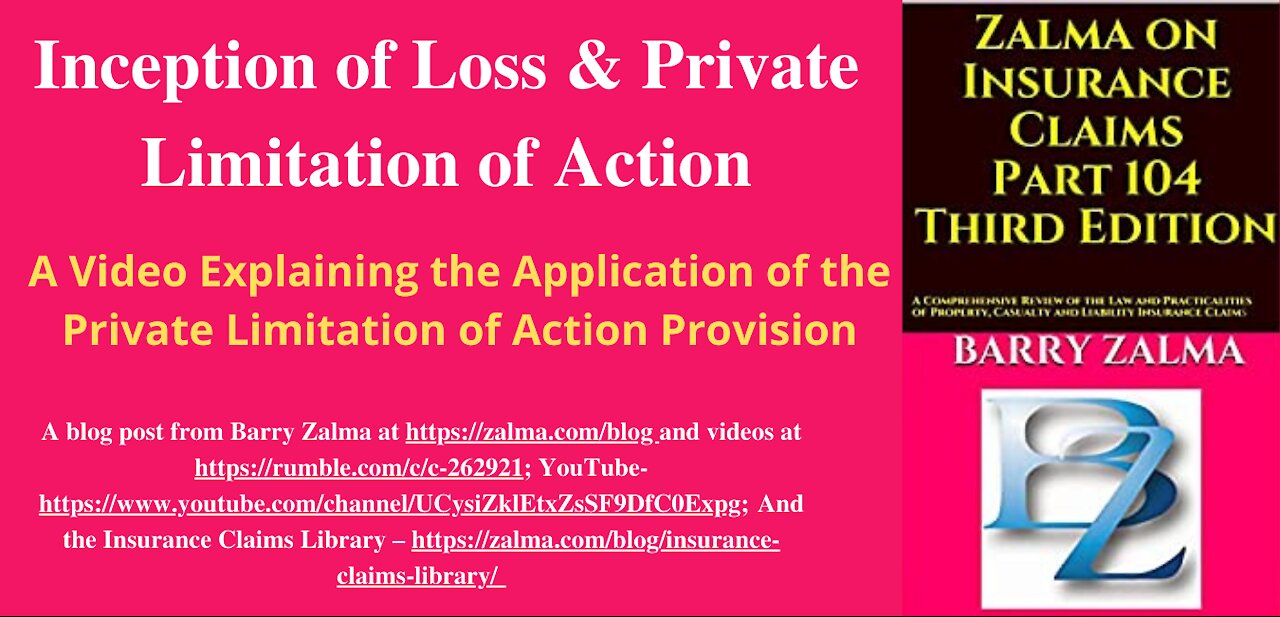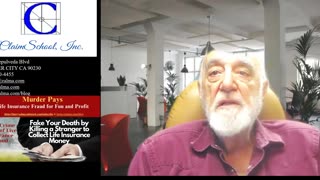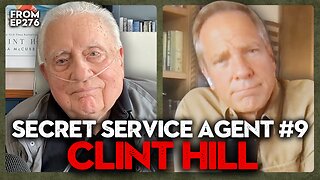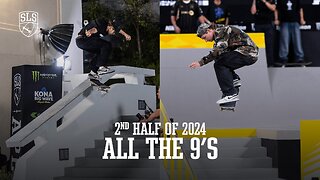Premium Only Content

A Video Explaining the Application of the Private Limitation of Action Provision
Inception of Loss & Private Limitation of Action
The phrase, “inception of the loss” in the standard fire insurance policy has been interpreted to mean “the occurrence of the casualty or event insured against.” [ See e.g., Zuckerman v. Transamerica Ins. Co., 133 Ariz. 139, 650 P. 2d 441 (1982) (Arizona law); Closser v. Penn Mut. Fire Ins. Co., 457 A. 2d 1081 (Del Supr 1983) (Delaware law); Sager Glove Corp. v. Aetna Ins. Co., 317 F. 2d 439 (7th Cir) (Illinois law), cert den 375 U.S. 921 (1963); Gremillion v. Travelers Indemnity Co., 256 La. 974, 240 So. 2d 727 (1970) (Louisiana law); and General State Authority v. Planet Ins. Co., 464 Pa. 162, 346 A. 2d 265 (1975) (Pennsylvania law).]
The Sixth Circuit held that a one-year limitations period after the inception of loss or damage in an insurance contract did not conflict with Kentucky law and was reasonable. [Smith v. Allstate Ins. Co., 403 F.3d 401, 402-04 (6th Cir. 2005); Miller v. Seneca Specialty Ins. Co. (W.D. Ky., 2019)]
The inception of loss means “the time when the loss was first incurred or began to accrue.” [Tucker v. State Farm Mut. Auto Ins., 2002 UT 54, ¶¶ 13-14, 53 P.3d 947].
In 1885, the California Court of Appeal found the one year private limitation to be enforceable unless the plaintiff established that negotiations with the defendant insurer established a waiver or caused the insurer to be estopped from asserting the provision as a defense. [Garido v. American Cent. Ins. Co. of St. Louis, 2 Cal Unrep. 560, 8 P. 512 (1885).] Finding no evidence of waiver or evidence to support estoppel, the defense verdict was affirmed.
In Sarmiento v. Grange Mutual Casualty Company, 106 Ohio St.3d 403, 2005-Ohio-5410 (2005), the court found that a two-year contractual limitation period for filing uninsured- and underinsured-motorist claims is reasonable and enforceable, regardless of whether the foreign state in which the accident occurred provides a longer statute of limitations for the underlying tort claim.
ZALMA OPINION
Every person insured and every lawyer representing a policyholder must undertstand the fact that insurance policies contain private limitation of action provisions and, if there is a dispute, the suit must be filed before the expiration of the private limitation not the state’s statute of limitations.
© 2021 – Barry Zalma Barry Zalma, Esq., CFE, now limits his practice to service as an insurance consultant specializing in insurance coverage, insurance claims handling, insurance bad faith and insurance fraud almost equally for insurers and policyholders.
He also serves as an arbitrator or mediator for insurance related disputes. He practiced law in California for more than 44 years as an insurance coverage and claims handling lawyer and more than 54 years in the insurance business.
He is available at http://www.zalma.com and zalma@zalma.com. Mr. Zalma is the first recipient of the first annual Claims Magazine/ACE Legend Award. Over the last 53 years Barry Zalma has dedicated his life to insurance, insurance claims and the need to defeat insurance fraud. He has created the following library of books and other materials to make it possible for insurers and their claims staff to become insurance claims professionals.
Go to the podcast Zalma On Insurance at https://anchor.fm/barry-zalma; Follow Mr. Zalma on Twitter at https://twitter.com/bzalma; Go to Barry Zalma videos at Rumble.com at https://rumble.com/c/c-262921; Go to Barry Zalma on YouTube- https://www.youtube.com/channel/UCysiZklEtxZsSF9DfC0Expg; Go to the Insurance Claims Library – https://zalma.com/blog/insurance-claims-library/ The last two issues of ZIFL are available at https://zalma.com/zalmas-insurance-fraud-letter-2/ podcast now available at https://podcasts.apple.com/us/podcast/zalma-on-insurance/id1509583809?uo=4
-
 13:02
13:02
Barry Zalma, Inc. on Insurance Law
1 year agoMurder Pays
3581 -
 18:48
18:48
Barry Zalma, Inc. on Insurance Law
3 years agoA Video Explaining Construction Experts
617 -
 49:04
49:04
Lights, Camera, Barstool
1 day agoIs The Monkey The Worst Movie Of The Year?? + Amazon Gets Bond
2.65K -
 24:19
24:19
Adam Carolla
18 hours agoDiddy’s Legal Drama Escalates, Smuggler Caught Hiding WHAT? + Philly Eagles & The White House #news
1.28K1 -
 10:12
10:12
Mike Rowe
2 days agoClint Hill: What A Man. What A Life. | The Way I Heard It with Mike Rowe
5.6K5 -
 1:31:52
1:31:52
Redacted News
2 hours agoBOMBSHELL! This is war! FBI whistleblowers reveal Epstein files being destroyed? | Redacted News
70.7K99 -
 48:55
48:55
Candace Show Podcast
2 hours agoSTOP EVERYTHING. They FINALLY Mentioned ME In The Blake Lively Lawsuit! | Candace Ep 152
49.4K28 -
 1:02:51
1:02:51
In The Litter Box w/ Jewels & Catturd
22 hours agoWhere are the Epstein Files? | In the Litter Box w/ Jewels & Catturd – Ep. 750 – 2/26/2025
50K46 -
 LIVE
LIVE
Revenge of the Cis
3 hours agoLocals Episode 198: Suits
489 watching -
 1:38:56
1:38:56
SLS - Street League Skateboarding
1 day agoTop Moments from the Second Half of the 2024 SLS Championship Tour! All The 9’s 🔥
25.5K1